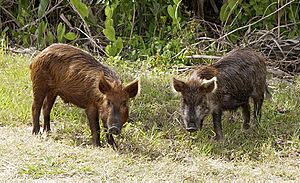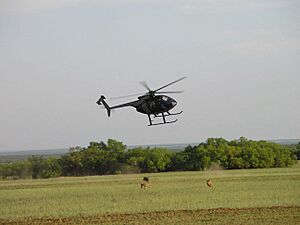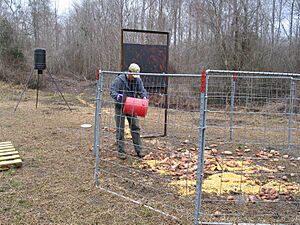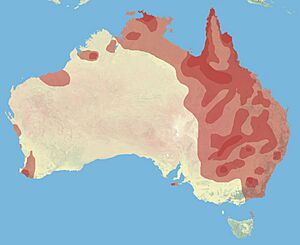Feral pig facts for kids

A feral pig is a domestic pig that has gone wild. This means it lives freely in nature, not on a farm. Sometimes, people also call wild boars "feral pigs," especially since wild boars and domestic pigs can have babies together. You can find feral pigs mostly in the Americas and Australia. In the United States, people sometimes use names like razorback or wild hog for these animals.
Contents
What is a Feral Pig?
A feral pig is a domestic pig that has either escaped from a farm or was set free on purpose. These pigs then live like wild animals. It's important to know that zoologists (animal scientists) usually don't call truly wild animals that escape from captivity "feral." For example, a Eurasian wild boar that escapes in North America isn't usually called feral, even if it mixes with feral pigs.
Feral Pigs in North America
United States: A Growing Problem

Domestic pigs first arrived in the Americas in the 1500s. Christopher Columbus brought them to the West Indies on his second trip to have food for future explorers. Later, Hernando de Soto brought them to Florida in 1539. More pigs were brought to the New World throughout the 16th and 17th centuries. By the 1800s, there were enough feral pigs in places like the Southern United States for them to become a common animal to hunt.
Today, feral pigs are a big problem in the United States. They also cause issues in the southern prairies of Canada. Around 2013, there were about 6 million feral pigs in the U.S. They cause billions of dollars in damage to farms and land every year. These pigs dig for food with their snouts and tusks, which can ruin large fields in just a few nights.
Since feral pigs eat almost anything (they are omnivores), they harm both plants and animals that naturally live in an area. They compete with animals like deer and turkeys for food. They also eat plants like the Opuntia cactus. Feral pigs can carry at least 34 types of pathogens (germs) that can spread to farm animals, wild animals, and even humans. Farmers worry that these pigs could bring back diseases like classical swine fever, which has been gone from the U.S. since 1978.
By the early 2000s, feral pigs lived in all U.S. states south of 36° north. Their range stretches from the mountains of California, across to the bayous of Louisiana, and all the way to Florida. In the East, they have spread north into the forested areas and swamps of the Southeast, and even up the Appalachian Mountains to upstate New York. Texas has the most feral pigs, with about 2.5 to 2.6 million. They cause about $50 million in farm damage each year in Texas.
Controlling Feral Pig Populations
To control the number of feral pigs, hunters in America try to trap and kill as many as they can. Most state wildlife departments see feral pigs as a threat to the environment. Some even call them pests. For example, the Wisconsin Department of Natural Resources allows hunting them all year round with no limits.
Hunting with dogs is very common, especially in the Southeast. Dogs like American Pit Bull Terriers, Catahoulas, and Dogo Argentinos are often used. These dogs are known for their toughness and loyalty during the hunt.
Canada: Adapting to the Cold
Feral pigs have become an invasive species in Canada, especially in the western and central parts. They were first brought in as farm animals in the late 1980s and early 1990s. These animals are a mix of European wild boars and domestic pigs. They have learned to survive in Canada's cold weather.
Canadian farmers started bringing wild boars from Europe for meat. Some of these animals escaped by digging under fences or breaking through them. Others were let go on purpose when the market for boar meat went down. At first, people didn't worry much, thinking the pigs couldn't survive Canadian winters. But the population has grown and spread a lot.
These mixed-breed pigs can weigh 600 pounds or more, which is much bigger than European wild boars. They have special features that help them:
- Sharp tusks
- Thick, bristly fur for warmth
- They can handle cold very well
- They have many piglets at once (up to six, twice a year)
- They build "pigloos" – shelters made from plants like cattails to stay warm in winter
Studies from the University of Saskatchewan show that feral pigs have spread across western and central Canada, from British Columbia to Manitoba. Their numbers have grown a lot between 1990 and 2017.
Feral Pigs in Hawaii
A study of pig genes found that the first pigs were brought to Hawaii by Polynesians around the year 1200. More types of European pigs arrived after Captain Cook came to Hawaii in 1778. These pigs eat or prey on endangered birds and plants. The number of feral pigs in the U.S. has grown from 2 million in 20 states in 1990 to three times that number 25 years later, spreading to 38 states. They are now moving north into states like Oregon and Pennsylvania. Some of these feral pigs have mixed with Russian boars that were brought in for hunting since the early 1990s.
Feral pigs eat almost anything. About 85-90% of their diet is plants, and the rest is animals. Plants in North America have trouble growing back after pigs dig them up. This is because North American plants didn't evolve to handle such damage, unlike plants in Europe or Asia. Feral pigs in the U.S. eat small animals like insects and worms. They also eat wild turkey chicks, toads, tortoises, and the eggs of reptiles and birds. This means less food for other wild animals.
Feral pigs have a high reproductive rate. A female pig can get pregnant as young as six months old and have several litters of piglets each year. This helps them out-compete other wildlife. In the fall, animals like the American black bear also look for tree mast (fruits from forest trees), so they compete directly with feral pigs for food. These are likely reasons why feral pigs reduce the variety of species in areas they invade.
In the U.S., the problems caused by feral pigs are worse because few animals hunt them. Predators like bobcats and coyotes might sometimes catch piglets or weak pigs. But they are not big enough to take on a full-grown boar, which can be three times their weight. In Florida, feral pigs are an important part of the Florida panther's diet. Other animals that could hunt them include the gray wolf, red wolf, cougar, jaguar, American alligator, American black bear, and grizzly bear. However, many of these large predators are rare or no longer live in areas with many feral pigs. Programs exist to protect these predators, but it will take a long time for them to return to their old homes.
Feral Pigs in South America
In South America, free-ranging boars were brought to Uruguay in the early 1900s for hunting. They eventually crossed into Brazil in the 1990s and quickly became an invasive species. Hunting these feral boars and their mixes with domestic pigs was allowed in southern Brazil starting in 2005. More pigs escaped from farms, and by 2008, hunting had to be expanded to other states.
These newer Brazilian boar populations are different from older groups of feral domestic pigs. These older groups have lived in places like the Pantanal for over 100 years, alongside native wild pigs called peccaries. Scientists are still studying how feral pigs affect peccary populations. Sometimes, feral pigs might help peccaries by becoming a food source for jaguars, as jaguars prefer hunting pigs when they are available.
Feral Pigs in Australia

The first time pigs were intentionally released in Australia was by Captain James Cook in 1777 at Adventure Bay, Bruny Island. He wanted to introduce animals and plants to new lands. He left a male and female pig in the woods by a freshwater stream. It was common to release pigs into new areas. As recently as the early 1970s, pigs were brought to Babel Island, but they were later removed.
On Flinders Island, feral pigs often go into farm areas next to national parks and swamps. Farmers say the damage is usually small, mostly just digging in pastures near bushy areas. However, in the Strzelecki National Park on the island, the environment has been badly damaged. Lots of digging in the valleys has led to soil erosion and the loss of young forest plants. A plant called Bracken fern (Pteridium esculentum) grows very well in these damaged areas, forming thick stands that block sunlight from reaching the forest floor.
Since 1987, feral pigs have been seen as the most important mammal pest for Australian farms. Feral pigs might also be a new food source for crocodiles, which could help crocodile populations grow.
Safety Around Feral Pigs
Feral pigs can be dangerous to people, especially when they are in groups with their young. It's best to stay away from them if you see them. In the United States, there have been over 100 recorded attacks by feral pigs on humans between 1825 and 2012. Five of these attacks were fatal. Three of the fatal attacks happened when hunters had wounded the pigs. Both male and female feral pigs have been known to attack without being provoked. Attacks by single males and by groups of pigs have been reported.
See also
- Boar hunting
- Boar–pig hybrid
- Hog-dog rodeo
- Pig wrestling




